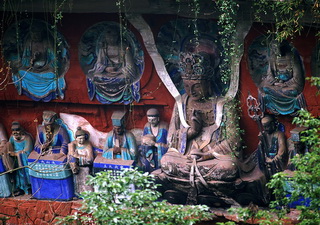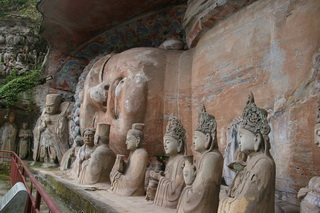 Situated in the southeast of the Sichuan Basin, 167 kilometers away from the east of Chongqing, The Dazu Rock Carvings are one of ancient China's most valuable treasures. They were declared a National Key Cultural Relics Protected Unit in 1961, and in 1999 they were listed as a World Culture Heritage Site.
Situated in the southeast of the Sichuan Basin, 167 kilometers away from the east of Chongqing, The Dazu Rock Carvings are one of ancient China's most valuable treasures. They were declared a National Key Cultural Relics Protected Unit in 1961, and in 1999 they were listed as a World Culture Heritage Site. Just about a 30 minute hike from Dazu town, North Hill sculptures include over 10,000 figures of Buddhas and Bodhisattvas in various poses; they are famous for their elegance and exquisiteness. The development of Chinese grotto art is obvious as one compares figures from earlier and later periods. The figures carved during the Tang Dynasty are decorous, full and round in appearance, and simple and honest in temperament. The sculptures carved during the period of the Five Dynasties are ingenious, subtle, and dainty, with natural and unrestrained looks. The images from the time of the Song Dynasty are graceful in posture and well-proportioned in physical build; their garments are gorgeous beyond description. Human beings and deities are ingeniously and skillfully merged in the sculptures.
Just about a 30 minute hike from Dazu town, North Hill sculptures include over 10,000 figures of Buddhas and Bodhisattvas in various poses; they are famous for their elegance and exquisiteness. The development of Chinese grotto art is obvious as one compares figures from earlier and later periods. The figures carved during the Tang Dynasty are decorous, full and round in appearance, and simple and honest in temperament. The sculptures carved during the period of the Five Dynasties are ingenious, subtle, and dainty, with natural and unrestrained looks. The images from the time of the Song Dynasty are graceful in posture and well-proportioned in physical build; their garments are gorgeous beyond description. Human beings and deities are ingeniously and skillfully merged in the sculptures.
15km northeast of Dazu town, the sculptures at Baoding Hill comprise the best of  Dazu's art. The founding work is attributed to Zhao Zhifeng (1179-1245), a monk from the Esoteric Sect of Tantric Buddhism. The masterpiece is a 31m-long, 5m-high reclining Buddha, depicted in the state of entering nirvana. Statues around the rest of the 125m horseshoe vary considerably Buddhist sages and preachers, historical figures, realistic scenes and delicate sculptures a few centimeters in height. The sculptures demonstrate a skillful combination of scientific principles and artistic models, reflecting the rich social context and very flavor of life of ancient Chinese people.
Dazu's art. The founding work is attributed to Zhao Zhifeng (1179-1245), a monk from the Esoteric Sect of Tantric Buddhism. The masterpiece is a 31m-long, 5m-high reclining Buddha, depicted in the state of entering nirvana. Statues around the rest of the 125m horseshoe vary considerably Buddhist sages and preachers, historical figures, realistic scenes and delicate sculptures a few centimeters in height. The sculptures demonstrate a skillful combination of scientific principles and artistic models, reflecting the rich social context and very flavor of life of ancient Chinese people.

 China Tours
China Tours Tibet Tours
Tibet Tours China Theme Tours
China Theme Tours Off The Beaten Track
Off The Beaten Track Yangtze Cruises
Yangtze Cruises China Trip Planner
China Trip Planner Travel Agents
Travel Agents China Tours
China Tours Tibet Tours
Tibet Tours China Theme Tours
China Theme Tours Off The Beaten Track
Off The Beaten Track Yangtze Cruises
Yangtze Cruises China Trip Planner
China Trip Planner Travel Agents
Travel Agents


 0086-28-85711328
0086-28-85711328 0086-28-85546015
0086-28-85546015





 Situated in the southeast of the Sichuan Basin, 167 kilometers away from the east of Chongqing, The Dazu Rock Carvings are one of ancient China's most valuable treasures. They were declared a National Key Cultural Relics Protected Unit in 1961, and in 1999 they were listed as a World Culture Heritage Site.
Situated in the southeast of the Sichuan Basin, 167 kilometers away from the east of Chongqing, The Dazu Rock Carvings are one of ancient China's most valuable treasures. They were declared a National Key Cultural Relics Protected Unit in 1961, and in 1999 they were listed as a World Culture Heritage Site. Just about a 30 minute hike from Dazu town, North Hill sculptures include over 10,000 figures of Buddhas and Bodhisattvas in various poses; they are famous for their elegance and exquisiteness. The development of Chinese grotto art is obvious as one compares figures from earlier and later periods. The figures carved during the Tang Dynasty are decorous, full and round in appearance, and simple and honest in temperament. The sculptures carved during the period of the Five Dynasties are ingenious, subtle, and dainty, with natural and unrestrained looks. The images from the time of the Song Dynasty are graceful in posture and well-proportioned in physical build; their garments are gorgeous beyond description. Human beings and deities are ingeniously and skillfully merged in the sculptures.
Just about a 30 minute hike from Dazu town, North Hill sculptures include over 10,000 figures of Buddhas and Bodhisattvas in various poses; they are famous for their elegance and exquisiteness. The development of Chinese grotto art is obvious as one compares figures from earlier and later periods. The figures carved during the Tang Dynasty are decorous, full and round in appearance, and simple and honest in temperament. The sculptures carved during the period of the Five Dynasties are ingenious, subtle, and dainty, with natural and unrestrained looks. The images from the time of the Song Dynasty are graceful in posture and well-proportioned in physical build; their garments are gorgeous beyond description. Human beings and deities are ingeniously and skillfully merged in the sculptures.  Dazu's art. The founding work is attributed to Zhao Zhifeng (1179-1245), a monk from the Esoteric Sect of Tantric Buddhism. The masterpiece is a 31m-long, 5m-high reclining Buddha, depicted in the state of entering nirvana. Statues around the rest of the 125m horseshoe vary considerably Buddhist sages and preachers, historical figures, realistic scenes and delicate sculptures a few centimeters in height. The sculptures demonstrate a skillful combination of scientific principles and artistic models, reflecting the rich social context and very flavor of life of ancient Chinese people.
Dazu's art. The founding work is attributed to Zhao Zhifeng (1179-1245), a monk from the Esoteric Sect of Tantric Buddhism. The masterpiece is a 31m-long, 5m-high reclining Buddha, depicted in the state of entering nirvana. Statues around the rest of the 125m horseshoe vary considerably Buddhist sages and preachers, historical figures, realistic scenes and delicate sculptures a few centimeters in height. The sculptures demonstrate a skillful combination of scientific principles and artistic models, reflecting the rich social context and very flavor of life of ancient Chinese people.